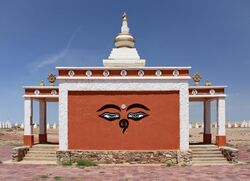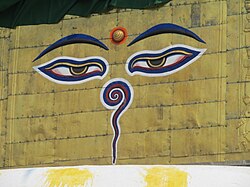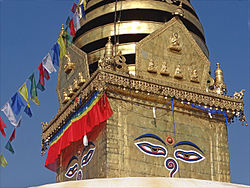Religion:Eyes of Buddha

The Eyes of Buddha (also called Buddha eyes or Wisdom eyes[1]) is a symbol used in Buddhist art. The symbol depicts two half-closed eyes, a style sometimes referred to as the Adamantine View (Sanskrit: Vajradrsti).[2] In between and slightly above the eyes is a circle or spiral which represents the urna,[3] one of the thirty-two characteristics of a great man (Sanskrit: Mahāpuruṣalakṣaṇa) in Buddhism.[2] Directly below the urna is a curly symbol stylized as १, which represents the number one in Devanagari numerals.[4][5] The curly symbol, which represents either a nose or a divine fire emanating from the urna above, symbolizes unity.[1]
The Eyes of Buddha symbol represents the all-seeing eyes of the Buddha,[6] or sometimes more specifically represents the eyes of the Ādibuddha.[1]
On stupas
The Eyes of Buddha are painted[7] onto the upper portions of many Tibetan-style stupas, mostly throughout Nepal.[1][8] The symbol is painted on all four sides of the cube at the top of the stupa to symbolize the Buddha's wisdom seeing all things in all four cardinal directions.[1] Two of the most well-known examples are the historic stupas at Swayambhunath[9] and Boudhanath,[10] which both comprise two of the seven Kathmandu Valley UNESCO World Heritage Site monuments located in Kathmandu in Nepal.[11]
Other uses
Similar to its use on stupas, the symbol is painted on the upper portion of many caityas.[2] The symbol is also sometimes inscribed on mani stones alongside the Sanskrit mantra Om mani padme hum as a form of prayer in Tibetan Buddhism.[12]
The Eyes of Buddha are painted on the silo housing the world's largest kaleidoscope, the Kaatskill Kaleidoscope in Mount Tremper, New York.[13]
References
- ↑ 1.0 1.1 1.2 1.3 1.4 Issitt, Micah L. (2014). Hidden religion : the greatest mysteries and symbols of the world's religious beliefs. Santa Barbara, California: ABC-Clio. pp. 188. ISBN 978-1-61069-477-3. OCLC 870699557. https://www.worldcat.org/oclc/870699557. Retrieved 9 August 2022.
- ↑ 2.0 2.1 2.2 Gutschow, Niels (1997). The Nepalese caitya : 1500 years of Buddhist votive architecture in the Kathmandu Valley. Stuttgart: Menges. pp. 21. ISBN 3-930698-75-7. OCLC 38029358. https://www.worldcat.org/oclc/38029358. Retrieved 9 August 2022.
- ↑ Fingesten, Peter (1959). "Sight and Insight: A Contribution Toward An Iconography of the Eye". Criticism 1 (1): 19–31.
- ↑ Penney, Sue (2001). Buddhism. Chicago: Heinemann Library. pp. 26. ISBN 1-57572-354-9. OCLC 44612945. https://www.worldcat.org/oclc/44612945. Retrieved 9 August 2022. "On all four sides of the stupa, painted eyes represent the all-seeing eyes of Buddha. The 'nose' between them is a Nepalese number one, a symbol of unity."
- ↑ Gautam, Bhim Lal (2022-02-01). "Language politics in Nepal: A socio-historical overview" (in en). Journal of World Languages 7 (2): 355–374. doi:10.1515/jwl-2021-0010. ISSN 2169-8260. "The Nepali language in the Devanagari script is the language of the nation of Nepal.".
- ↑ "Nepal an exotic nation". Alberni Valley Times: pp. 13. 21 July 1972. https://www.newspapers.com/clip/107250607/.
- ↑ Marceau, Jo (1998). Art : a world history. London: Dorling Kindersley. pp. 338. ISBN 0-7513-0453-0. OCLC 40050950. https://www.worldcat.org/oclc/40050950. Retrieved 9 August 2022.
- ↑ Olschak, Blanche Christine; Wangyal, Geshé Thupten (December 1974). "Lotus eyes of the Buddha". UNESCO Courier 27 (11): 28–29. https://archive.org/details/sim_unesco-courier_1974-12_27_11/page/n27/mode/2up?q=%22Eyes+of+Buddha%22.
- ↑ Ostrowski, A. (2006). "The Framing of Religion: Nepal TV Explored". South Asian Popular Culture 4 (1): 3–18. doi:10.1080/14746680600555410. https://dx.doi.org/10.1080/14746680600555410. Retrieved 9 August 2022.
- ↑ "Nepal's earthquake-hit Boudhanath stupa reopens after restoration". The Guardian. 22 November 2016. https://www.theguardian.com/global-development/2016/nov/22/nepals-earthquake-hit-boudhanath-stupa-reopens-after-restoration-private-donations.
- ↑ "Kathmandu Valley". https://whc.unesco.org/en/list/121.
- ↑ Gurawa, Anju (2009). Tibetan diaspora : Buddhism and politics. New Delhi, India: National Book Organisation. pp. 40. ISBN 978-81-87521-24-2. OCLC 320661925. https://www.worldcat.org/oclc/320661925. Retrieved 9 August 2022.
- ↑ Gitter, Dean (26 July 1996). "Buddhist Symbol at Home in the Catskills". The New York Times: pp. A–28. https://www.nytimes.com/1996/07/26/opinion/l-buddhist-symbol-at-home-in-the-catskills-012157.html.
 |



